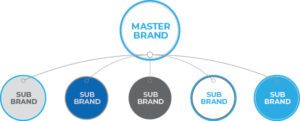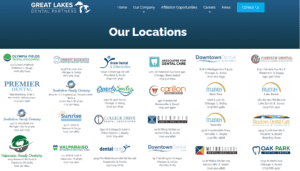How you want to run your DSO ultimately depends on your own preferences and what works for the businesses you work with, but there are clear advantages and disadvantages to each structure option. When it comes to marketing for a DSO, and within the healthcare industry in general, it’s essential to understand the ins and outs of the right choice, which is why we’re talking about it here.
In this article, we’ll be diving into the debate of a branded house vs. house of brands approach for DSOs by talking about the pros and cons of both:
- Branded House Structure
- House of Brands Structure
About Branded House Structuring
Working under one branded house is also known as market centralization, which happens during the post-merger integration (PMI) phase of your business dealings. Basically, this process involves incorporating all your new brands under your brand name by centralizing marketing activities in a seamless way.
This has worked successfully for many brands, including Aspen Dental, Heartland Dental, and Dental Care Alliance, which are able to provide care to patients across the United States under one parent company’s name.

Related: How Marketing Centralization Helps DSOs Accelerate Growth
Branded House Pros
There are countless advantages to centralizing your marketing strategies and unifying your acquired brands underneath one brand name. It helps maximize efficiency and profitability all while taking a lot of hard work off your shoulders so that you can focus on other aspects of your DSO. Let’s dive a bit deeper into the main upsides of a branded house structure.
Convenient and Efficient Brand Management
With a branded house, you will only have a single, brand to focus on, which means you only have to focus on a single website, logo, brand message, and tech stack. Within a tech stack, you’ll be able to have a singular CRM system, call center, call tracking software, online scheduling systems, chatbots, and more.
This centralization of all these different systems will make life easier for you and the businesses working with you.
Easier to Build Brand Awareness
With a holistic marketing strategy at work, you can create a sense of cohesion and unity amongst all these brands you’ve acquired, making you much more noticeable and trustworthy to potential patients.
Since your brand will be well-known and accessible to many people, you will have more opportunities to present new offers and products to your clientele. This is because customers will be much more willing to accept change from a brand they know and trust.
Better Scalability
Having one brand also makes scaling easier since you won’t have to start from scratch every time you acquire a new dental practice or open a new location. Instead, you’ll have repeatable patient acquisition processes in place that you can quickly implement. This will allow you to maximize profitability by ensuring new locations are ready to accept patients as soon as possible.
With everything being so streamlined, it will also be much easier to identify issues with scaling, so you can quickly adjust your strategies and get every brand back on track. Ultimately, you will save yourself a lot of time and energy by only having to do this once rather than over and over again.
Branded House Cons
Despite all the advantages of using a branded house marketing strategy, there are a handful of downsides as well. With everything under one umbrella, you may find yourself having issues with maintaining a positive reputation, building trust with consumers, acquiring new dental brands, and more.
Here are some more concepts for you to consider before you make a decision.
Reputation Relies on the Parent Brand
Arguably, the biggest pitfall of a branded house is how much it relies on the reputation of just one brand. All locations are tied directly to your DSO, which means if your image takes a hit, every entity underneath you does, too.
These days, consumers are already distrusting of brands, especially large corporations. This leads to many developing an “all or nothing” approach when it comes to reacting to malpractices. One bad hit to your reputation can potentially lose a large portion of your client base, and it won’t be a simple task to win them back.
Lack of Trust from Potential Customers of These Dental Brands
Like we stated above, consumers don’t naturally trust businesses. Plus, people don’t love the idea of large “corporate” entities either. While having all your brands underneath one name improves brand awareness, it can also lead to a lack of trust.
This isn’t because you’re doing something wrong; it more has to do with having fewer opportunities to form a real relationship with your customers. In many cases, patients will feel like this is more transactional and are searching for some form of an established relationship.
This mentality is what drives so many people to family-owned and operated businesses rather than corporations, and it is something you will have to navigate around with a branded house if you want to gain loyal customers.
Related: Shining a Light on Your Dentists: DSO Marketing That Patients Love
Challenges with Acquisition and Integrating New Dental Brands
With a branded house, it’s not only hard to gain loyal customers; it’s hard to acquire existing dental practices and brands, too. Established dental group owners often feel a strong connection to their brand and don’t want to feel like they are “selling out” to a larger entity that will undo their hard work and essentially erase their legacy.
This is definitely a tough one to work around because you will be making changes to their organization. When navigating this issue, it’s important not to lie about your intentions but still compromise with them to ensure they know they still have a say in their business.
Once you do land a new practice, the hard part will not be over. With a strong sense of brand loyalty in place, it can often be difficult to get their team on board with your new branding guidelines. So, you will have to work harder to keep them happy as you’re incorporating them into your branded house.
About House of Brands Structuring
Instead of housing all your acquired brands under one name, house of brands structuring allows each business to keep its own name, logo, identity, and more, giving them a greater sense of identity while still getting to enjoy the benefits of being a part of a DSO.

House of Brands Pros
There are many benefits to having a house of brands rather than a branded house. For starters, this type of structuring allows for more diversification in terms of consumer bases and usually makes the dental companies themselves feel more comfortable. Here are some of the top advantages to having a house of brands.
More Options for Personalization and Customer Retention
While a unified front holds many benefits, individualization does, too. By having unique brands, you have many more opportunities for personalizing each one and creating a customized experience for new and returning patients.
With healthcare being a personal and sensitive industry, being able to form a relationship with their provider is helpful for customer retention in the long run. Overall, it is much easier to build trust and form a relationship with clients as a unique brand rather than as a large corporation.
More Diverse Target Audiences
Moreover, having unique brands will make it easier to reach a larger target audience as well. Instead of operating underneath one branding strategy, each practice can have its own messaging and overall aesthetic, which can be incredibly helpful when it comes to attracting diverse customer segments.
Some examples of these different market niches include:
- Boutique Cosmetic Dentistry
- Family Dentistry
- Sedation Dentistry
- Budget Dentistry
- Orthodontics
…and more!
Client Acquisitions are Much Easier
By allowing dental groups to retain their individual brand identities, you’ll find that it is typically much easier to sign on new practices with a house of brands.
Dentists will feel better knowing they still have their own identity while enjoying the other advantages of joining your DSO. With this structure in place, you will get to acquire many unique businesses and leverage their individuality.

House of Brands Cons
On the downside, having a house of brands structure will definitely leave you with more work as you’ll be handling individual brands as individuals. Furthermore, you won’t have as much power since your brands will be broken into separate spaces instead of being one entity.
Whether this extra work is worth it is up to you and how you wish to run your DSO, but we’ll dive a bit deeper into the more negative aspects of this type of marketing strategy, so you can get the full picture.
Overall Operations will be Less Efficient
One of the biggest pitfalls of a house of brands structure is it puts much more work on your shoulders as the DSO. Since you’ll be working with individual brands, that means you’ll be monitoring and managing separate websites, ad campaigns, marketing strategies, tech stacks, and everything in between.
To offset this extra work, it can be helpful to have a larger team working within your DSO, but this also comes at a cost. This is something to consider as you begin structuring and acquiring new dental groups.
Harder to Analyze Success
Since you’ll be managing all these separate systems for each dental practice, it can also be much more challenging to measure success and extrapolate useful metrics and data to drive your marketing strategies forward. There are plenty of helpful software programs out there to help with data analysis, but the bottom line is it will be more work for you.
It’s also challenging to tie disparate systems together. Tech integrations aren’t always easy, and you may not be able to gain insights across different brands or regions.
Challenging to Build Brand Awareness
Without a single branding strategy, it can be harder to build brand awareness on a larger scale. That sense of cohesion that a branded house offers won’t be there, which will hurt you in terms of being noticed by a large target audience.
To the average person who doesn’t really know how DSOs operate, each business underneath you will seem like a completely separate entity that has nothing to do with one another. While this is beneficial in terms of trust and loyalty, it takes a toll on overall brand awareness and equity.
Where Does Your DSO Fit Into the Picture?
When it comes to choosing the right structure for your dental support organization, it’s important to remember that everything is about balance. As you’ve learned from this article, both approaches have their advantages and setbacks, which means using just one approach might not be the right option for you.
In some markets, it might be beneficial for you to retain an existing brand instead of incorporating it under a branded house. On the other hand, if an acquired dental group has a poor reputation, it might be better to incorporate it into the main brand and start afresh.
At the end of the day, the decision is yours to make, so be flexible in your decisions. While you may be tempted to make a decision and stick to it, it’s okay to compromise. If you want to learn more about DSO new patient acquisition strategies, reach out to our team at Cardinal Digital Marketing.

